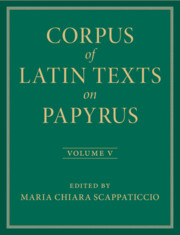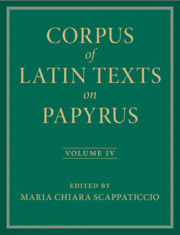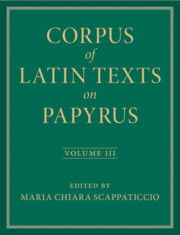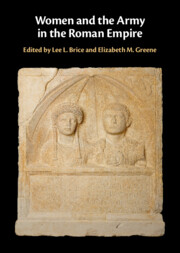Refine search
Actions for selected content:
72 results
3 - You Can’t Get There from Here
-
-
- Book:
- Palmyra, the Mediterranean and Beyond
- Published online:
- 21 October 2025
- Print publication:
- 16 October 2025, pp 33-48
-
- Chapter
- Export citation
8 - Channels of Communication and Connections of Style
-
-
- Book:
- Palmyra, the Mediterranean and Beyond
- Published online:
- 21 October 2025
- Print publication:
- 16 October 2025, pp 167-186
-
- Chapter
- Export citation

Corpus of Latin Texts on Papyrus
-
- Published online:
- 03 October 2025
- Print publication:
- 04 September 2025

Corpus of Latin Texts on Papyrus
-
- Published online:
- 03 October 2025
- Print publication:
- 04 September 2025

Corpus of Latin Texts on Papyrus
-
- Published online:
- 03 October 2025
- Print publication:
- 04 September 2025

Corpus of Latin Texts on Papyrus
-
- Published online:
- 26 September 2025
- Print publication:
- 04 September 2025

Corpus of Latin Texts on Papyrus
-
- Published online:
- 12 September 2025
- Print publication:
- 04 September 2025

Corpus of Latin Texts on Papyrus
-
- Published online:
- 12 September 2025
- Print publication:
- 04 September 2025
5 - Mother Courage and Her Children
-
-
- Book:
- Women and the Army in the Roman Empire
- Published online:
- 24 October 2024
- Print publication:
- 07 November 2024, pp 110-150
-
- Chapter
- Export citation
11 - Women and the Military in the Age of Justinian
-
-
- Book:
- Women and the Army in the Roman Empire
- Published online:
- 24 October 2024
- Print publication:
- 07 November 2024, pp 299-326
-
- Chapter
- Export citation
8 - Soldiers’ Wives en Route in Roman Egypt
-
-
- Book:
- Women and the Army in the Roman Empire
- Published online:
- 24 October 2024
- Print publication:
- 07 November 2024, pp 219-239
-
- Chapter
- Export citation
9 - The Role of Women in the Religious Activities of Roman Military Communities
-
-
- Book:
- Women and the Army in the Roman Empire
- Published online:
- 24 October 2024
- Print publication:
- 07 November 2024, pp 240-269
-
- Chapter
- Export citation
6 - Investigating Roles for Women inside Roman Military Bases through Artifact Distribution
-
-
- Book:
- Women and the Army in the Roman Empire
- Published online:
- 24 October 2024
- Print publication:
- 07 November 2024, pp 151-180
-
- Chapter
- Export citation
3 - Agrippina and Company
-
-
- Book:
- Women and the Army in the Roman Empire
- Published online:
- 24 October 2024
- Print publication:
- 07 November 2024, pp 54-83
-
- Chapter
- Export citation
1 - Present but not Accounted For
-
-
- Book:
- Women and the Army in the Roman Empire
- Published online:
- 24 October 2024
- Print publication:
- 07 November 2024, pp 1-20
-
- Chapter
- Export citation
2 - Approaches to Women and the Roman Army
-
-
- Book:
- Women and the Army in the Roman Empire
- Published online:
- 24 October 2024
- Print publication:
- 07 November 2024, pp 21-53
-
- Chapter
- Export citation
7 - (In)Visible Women and Children
-
-
- Book:
- Women and the Army in the Roman Empire
- Published online:
- 24 October 2024
- Print publication:
- 07 November 2024, pp 181-218
-
- Chapter
- Export citation
10 - Mater Castrorum
-
-
- Book:
- Women and the Army in the Roman Empire
- Published online:
- 24 October 2024
- Print publication:
- 07 November 2024, pp 270-298
-
- Chapter
- Export citation
4 - Elite Marriage and Adultery in the Camp
-
-
- Book:
- Women and the Army in the Roman Empire
- Published online:
- 24 October 2024
- Print publication:
- 07 November 2024, pp 84-109
-
- Chapter
- Export citation

Women and the Army in the Roman Empire
-
- Published online:
- 24 October 2024
- Print publication:
- 07 November 2024
